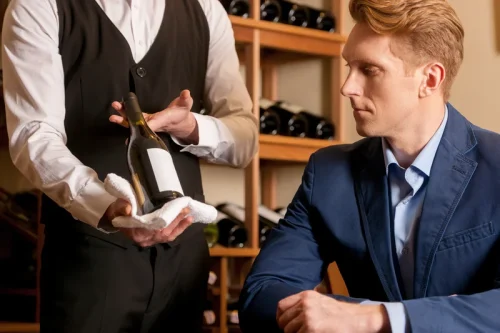

The Phony Negroni was already perfect, but the brilliant minds at St. Agrestis had to take things a step further. Now you can also get premade nonalcoholic espresso Negronis and a delightfully smoky, complex mezcal Negroni. If you’re more sober-curious than fully sober, popping one of their amaro-soaked cherries in the mezcal Negroni will kind of blow your mind. They also make a large format Amaro Falso if you prefer to experiment with your own mixology. You can start shopping online or in person for alcohol-free spirits and mixers or nonalcoholic beers and wines to shake up your happy hour routine. The company makes roughly 50 unique, nonalcoholic brews each year, ranging in style from hazy IPAs to a dark stout to a (very popular) golden ale.
The 14 Best Nonalcoholic Drinks, According to a Legendary Bartender
We also asked a few bartenders and industry experts from across the country to weigh in on their current favorite nonalcoholic picks. Our list of favorite picks includes juicy wine alternatives, nonalcoholic craft beers, and a spicy canned spritz. Forget the usual “and soda” booze alternatives that you get stuck with at parties! Seedlip distilled nonalcoholic spirits take fizzy drinks to another level. If you like a little mystery and surprise in your mocktails, Curious Elixirs should be your new go-to.


Ritual Zero-Proof Gin
- Grüvi cofounders Niki and Anika Sawni package most of their NA wines and beers in cans, which is an increasingly popular way of consuming wine.
- They also make St. Ember, what they call a “plant magic” spirit, designed to lift you up without the negative effects of alcohol.
- Newsweek spoke to experts to learn about how to avoid liquor as a means of relaxation and the benefits of alcohol alternatives.
- Older adults may be more vulnerable to these unpleasant effects, in part because drug metabolism slows with age.
- It’s spiced and spicy, with plenty of smoke flavor and some vegetal notes.
A sip leads with notes of cherry, citrus, currant, plum, and an almost sangria-like fruit funk; hints of rose, layers of warming spices (especially clove), and a slight ginger burn then round out each sip. Our tasters found Fiore complex enough—with a slight bitterness brought on by the ginseng root and orange rind—but grounded in an appealing sweetness that made it easier to drink than some of the more challenging bevs we tried. Mixed with tonic, I certainly wouldn’t mistake it for a real G+T and I don’t think it quite fills that craving if you’re sober-curious and missing your favorite happy hour cocktail. But the flavor is well-balanced enough that even with just tonic, or soda water and lemon, this is an enjoyable drink on its own. I love that you don’t need bartender skills to make a nice beverage with it.
How to choose a zero-proof beverage
I also really enjoyed its witchy branding and ended up saving the bottles to be reused as pretty simple syrup bottles and decor. I also love that the large bottle has the presence of wine or champagne so it makes for a great gift or dinner party addition (though it’s worth noting, alternatives to alcohol TÖST also makes 12 oz singles if you want to enjoy one on your own). Sometimes, a brewer may remove alcohol from the cider after fermentation through filtration or reverse osmosis. The Good Trade editors endorse products we’ve personally researched, tested, and genuinely love.


This has a profound impact on the environmental and economic sustainability of catalyst development programs that has not been explored. “Feel Free had a hold on me that I had never before experienced,” says Roberts. One turned into three, three turned into five, five turned into 10. I would drink as many as I could, spending whatever money I had.” A year after trying his first bottle of Feel Free, he said he maxed out four credit cards and sold most of his belongings to support the habit. At the height of his Feel Free use, he said he was drinking as many as 20 bottles per day, spending roughly $700 per week.
Keep in mind that while 0.5% or less ABV is considered a trace amount of alcohol, people who wish to avoid alcohol completely may want to select a beverage that is made without the production of alcohol. In the United States, a nonalcoholic beverage is one that contains less than 0.5% alcohol by volume (ABV) (1). Susan (she/her) is the recipe editor at Good Housekeeping, where she pitches ideas, parses words, and produces food content. In the Test Kitchen, she cooks (and samples!) recipes, working with developers to deliver the best written versions possible. She enjoys playing tennis, natural wines and reality competition shows. The latest release from Katy Perry isn’t a new album but a delightful spritz in a can called Trés Rosé.
Bitters aren’t for everyone, including pregnant folks and children, because of the alcohol content. You only need a dash to enhance a drink, but even a small amount still contains a bit of alcohol. Before getting to suggestions, just a reminder that nonalcoholic beer does contain some alcohol, though usually less than 0.5 percent ABV. Whatever your motivation for not imbibing, we’ve got your back with 10 alcohol alternatives to wet all kinds of whistles. Some companies are starting to roll out alcohol-free bitters, which are a good alternative if you’re looking to avoid alcohol completely. In addition to passing our taste test, every brand and product was thoroughly vetted by our team of medical experts.
Sparkling water with a slice of fruit
- CBD can give you the same sense of relaxation we get from alcohol without any chance of a hangover.
- Squeeze a lime, orange, or grapefruit wedge into the beverage for some flavor without affecting the calorie or carbohydrate content.
- If you or someone you know struggles with alcohol consumption, seek professional assistance quickly for support and guidance.
- A lot of craft breweries make low- or no-alcohol brews, so it’s worth hitting up local spots to see what they have.
- Similar to CBD, rhodiola rosea is an adaptogen, meaning it helps the brain adapt to stressors.
